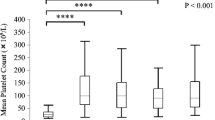Abstract
Backround: Currently, all treatments for patients with myelodysplastic syndrome (MDS) are still experimental. Supportive care, including treatment of infection and transfusion of blood and blood-related products, remains the most important aspect of therapy in these cases. This article discusses the results of partial splenic embolization in a patient who had MDS with refractory anemia.
Methods: The patient was placed under observation and was given supportive treatment. In addition to MDS with refractory anemia, there were management difficulties related to severe thrombocytopenia after alloimmunization from multiple blood transfusions. Therefore it is thought that partial splenic embolization might be an alternative treatment for the management thrombocytopenia.
Results: Although the patient did not live long because of the sepsis and ileus, hematologic response was obtained.
Conclusion: The observation during the treatment in this case suggests that partial splenic embolization may be a valid new alternative for treating thrombocytopenia due to alloimmunization.
Similar content being viewed by others
References
Fenaux P, Estienne MH, Lepelley P, et al. Refractory anemia according to the FAB classification: A report of 69 cases. Eur J Hematol 1988;40:318–325.
Koefler HF, Golde DW. Human preleukemia. An Intern Med 1980;93:347.
Noel P, Solberg LA Jr. Myelodysplastic syndromes. Pathogenesis, diagnosis, treatment. Crit Rev Oncol Haematol 1992;12:193.
Albitar N, Manshouri T, Shen Y, et al. Myelodysplastic syndrome is merely ‘preleukemia’.Blood 2002;100:791.
Hellström-Lindberg E, Willman C, Barrett JA, Saunthararajah Y. Achievements in the understanding and treatment of myelodysplastic syndromes. American Society of Hematology (Educ Program) 2000;110–132.
Greenberg P, Cox C, Le Beau MM, et al. International scoring system of for evaluating prognosis in myelodysplastic syndromes. Blood 1997;89:2079.
Legler TJ, Ficher I, Dittmann J, et al. Frequency and causes of refractoriness in multiple transfused patients. Annal Hematol 1997;74:85.
Yankee RA, Grumet FC, Rogentine GN. Platelet transfusion. The selection of compatible platelet donors for refractory patients by lymphocyte HLA typing. N Eng J Med 1969;281:1208.
Leukocyte reduction and ultraviolet B irradiation of platelets to prevent alloimmunization and refractoriness to platelet transfusions. The Trial to Reduced Alloimmunization to Platelet Study Group. N Eng J Med 1997 Dec 25;337(26):1861–1819
Willamson LM. Leukocyte depletion of the blood supply–-how will patients benefit? British J Haematol 2000;110:256.
Brittingham TC, Chaplin H Jr. Febrile transfusion reactions caused by sensitivity to donor leukocytes and platelets. JAMA 1975;165:819.
Heddle NM, Klama LN, Griffith L, et al. A prospective study to identify the risk factors associated with acute reactions to platelet and to red cell transfusions. Transfusion 1993;33:794.
Stack G, Synder EL. Cytokine generation in stored platelet concentrates. Transfusion 1994;34:20.
Shiffer CA, Anderson KC, Bennet CL, et al. Platelet transfusion for patients with cancer. Clinical practice guidelines of the American Society of Oncology. J Clinc Oncol 2001;19:1519.
Pallson N, Hallen M, Forsberg AM, Alwmark A. Partial splenic embolization: Long-term outcome. Langenbecks Arch Surg 2003;387(11–12):421–426.
Harned RK 2nd, Thompson HR, Kumpe DA, Narkewicz MR, Sokol RJ. Partial splenic embolization in five children with hypersplenism: Effect of reduced-volume embolization on efficacy and morbidity. Radiology 1998 Dec;209(3):830–836.
Kimura F, Itoh H, Ambiru S, et al. Long-term results of initial and repeated partial splenic embolization for the treatment of chronic idiopathic thrombocytopenic purpura. Am J Roentgenol 2002 Nov;179(5):1323–1326.
Politis C, Spigos DG, Georgiopoulou P, et al. Partial splenic embolization for hypersplenism of thalassaemia major. Br Med J 1987 Mar 14;294(6573):665–667.
Author information
Authors and Affiliations
Corresponding author
Rights and permissions
About this article
Cite this article
Ozdogu, H., Boga, C., Oğuzkurt, L. et al. Partial Splenic Embolization in Myelodysplastic Syndrome Associated with Immune Thrombocytopenia. J Thromb Thrombolysis 18, 213–216 (2004). https://doi.org/10.1007/s11239-005-0349-2
Issue Date:
DOI: https://doi.org/10.1007/s11239-005-0349-2




